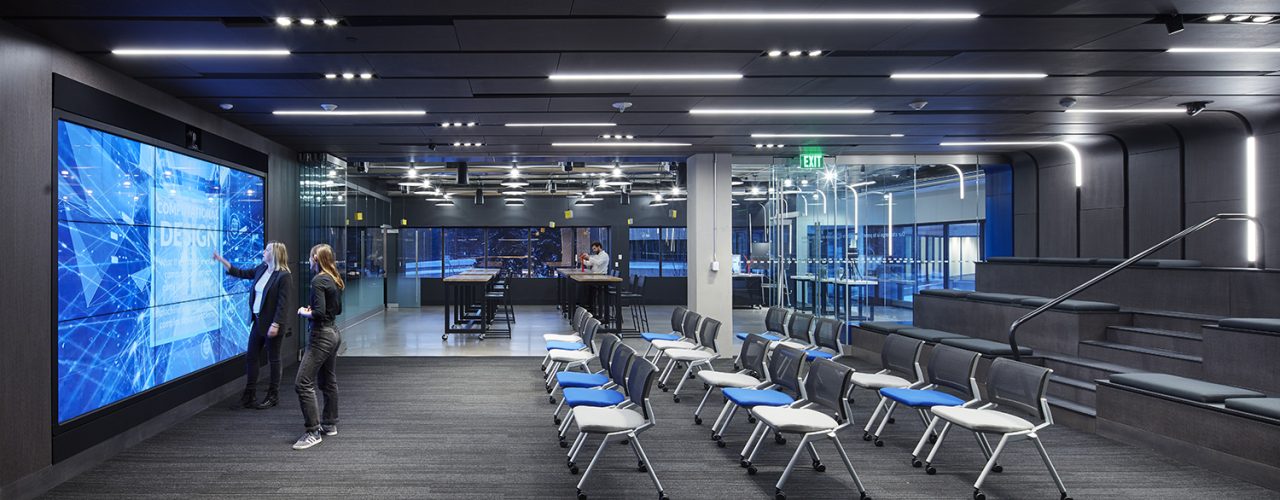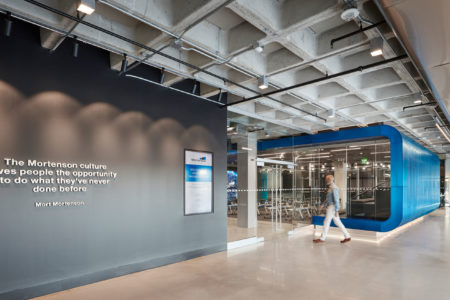Low-Voltage Direct Current and the Future of Commercial Office Buildings

RSP’s Chad Jones explains why low-voltage direct current (LVDC) system design is a critical component on the path toward a more sustainable built environment.
Headline-grabbing technologies and sweeping innovations like citywide smart grids and large-scale renewable energy sourcing tend to take center stage in discussions about the future of sustainability. But simpler solutions can often have an out-sized impact. Low-voltage direct current (LVDC), when installed in large, commercial settings, is one such solution that supports our steady march toward zero net energy built environments.
LVDC: The Basics
Since the late 1800s, alternating current (AC) power distribution has been the primary method of generating and distributing electricity. At the time, AC power could generate and distribute power over far greater distances than direct current (DC) power. But DC energy has been on the rise as energy sources begin to transition from central AC distribution plants to local DC microgrids. These microgrids utilize DC energy-producing resources such as solar photovoltaics and battery energy storage systems.
With continual advancements in power electronics, DC-based devices and systems are becoming much more common as well. Examples include LED lighting, computers, and HVAC motors. As devices continue to progress towards DC-based designs, which require less energy overall, it provides commercial office building owners, landlords and tenants the opportunity to supply these devices utilizing an LVDC power distribution scheme.
Ultimately, an LVDC distribution design in a commercial office increases space flexibility, simplifies the design and reduces energy consumption.
LVDC: The Benefits
According to Architecture 2030, the urban built environment is responsible for 75% of GHG emissions. As engineers, architects and designers strive toward zero net energy buildings, LVDC design and the proliferation of DC-powered devices coupled with the implementation of renewable energy sources can make a significant dent in GHG emissions.
There are other benefits to LVDC design that make it even more appealing to commercial office landlords and tenants:
- LVDC typically results in significant operating savings as installation requirements are far more lenient compared to traditional wiring. Installation requires a licensed low voltage contractor, rather than an electrician.
- Installation and modifications to the LVDC wiring typically do not require an intensive permitting process.
- Utilizing native DC loads significantly reduces energy consumption.
- LVDC systems can be easily integrated into zero net energy buildings utilizing DC-powered renewable energy sources.
In a 30,000-SF commercial office space, implementing an LVDC system for workstations, HVAC and other devices can reduce emissions and energy costs by as much as 15%.
LVDC and the Workplace of the Future
LVDC and the workplace of the future go hand-in-hand. Transitioning from a traditional, stationary configuration to a more flexible and fluid space design is one way to minimize the impact of commercial office buildings. And there’s no question that the future of the workplace is flexible.
For instance, an LVDC system makes it possible to replace a traditional computer desktop set-up with a laptop configuration that requires less energy consumption and can be powered directly via USB or wireless charging stations. Beyond workstations, LVDC design can save energy and costs on any number of native DC-powered devices. That includes TVs, LED lighting systems, printers, signage, motorized shades, exhaust fans and other mechanical components. Duplicate this across offices and hundreds or even thousands of workstations, and the cost and energy savings are undeniable.
With 5G networking and edge computing on the horizon, high-speed user connectivity will improve current functions like video conferencing. These innovations will also unlock the full potential for virtual reality and augmented reality in the workplace. Expanding technology applications will give employees more mobility, instant access to information and seamless connectivity. And LVDC can make that high-tech future a sustainable reality.








